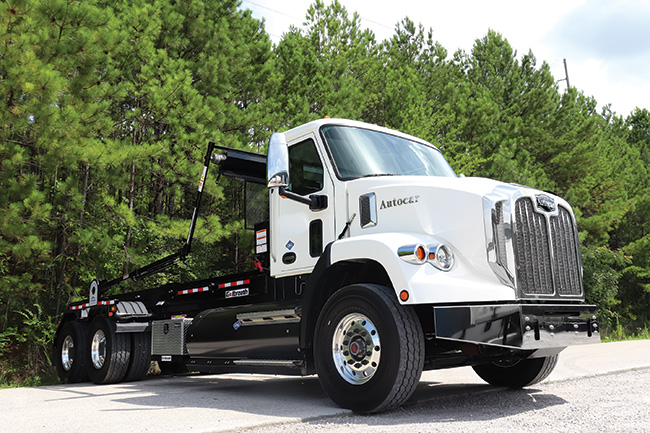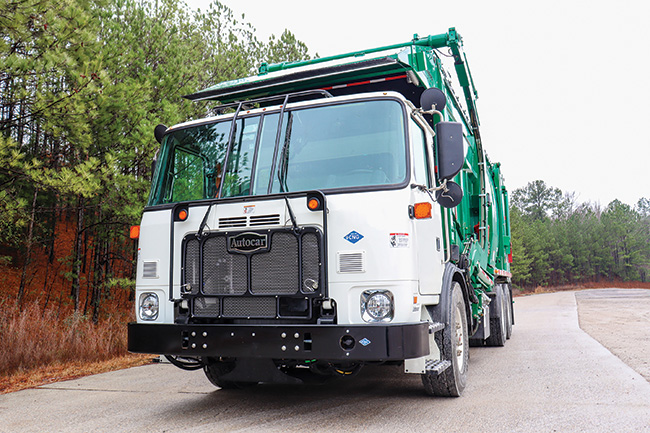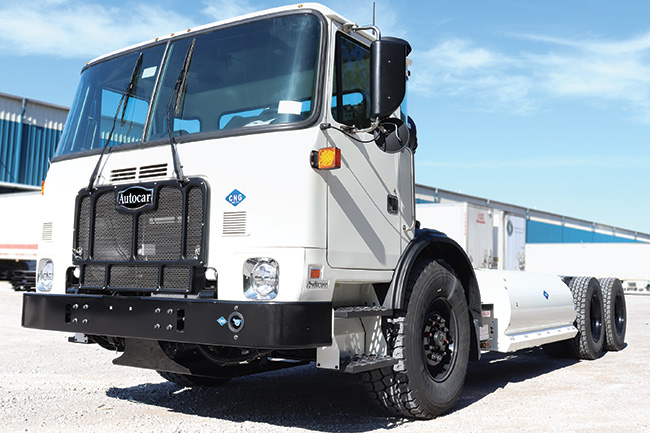Refuse management companies still have a long way to go to meet the requirements set forth to counteract the challenges of lowering emissions and costs. However, the technology and goals of the refuse industry provide a steppingstone in the right direction.
By Tim Thornton
One glance at the fuel prices these days creates a concern for the sustainability and realities of fossil fuel options. As diesel fuel prices continue to rise, refuse collection businesses are increasingly looking into alternatives such as compressed natural gas (CNG), renewable natural gas (RNG), and liquified natural gas (LNG). The benefits of these options in terms of cost and sustainability make them attractive options for refuse fleets looking to save money and reduce their environmental impact. OEMs (original equipment manufacturers) have been emphasizing the importance of alternative fuels for years, and this is likely to continue as the market for alternative fuels grows.
We think the market for refuse trucks, and vocational trucks in general, is only beginning the transition to alternative fuels and other sustainable options. While there are CNG powered refuse trucks currently in circulation, the market for these trucks has room to grow as a popular and necessary option for customers. However, for refuse fleets, investing in more CNG-powered and alternative fuel-powered trucks may not help to meet their ESG and operation needs alone. Intriguingly, a few fleets have worked to achieve greater cost reduction goals by opting to power their trucks with RNG produced through landfill gas recapture or landfill gas waste to energy conversion.

Inset: The ACX FL CNG-operated severe-duty cabover refuse truck is known for its reliability and durability that stands up to its diesel counterpart.

The Growing Importance and Need for RNG Refuse Truck Options
Rising diesel prices are only one factor contributing to the switch to engines that run on RNG. In addition, federal and state legislation has implemented mandates requiring vocational vehicles to reach emissions standards. As fleets transition to meet these requirements, the industry must adapt to the needs of the refuse industry by engineering trucks that can withstand the same challenges of the vocation, with the same power of their diesel counterparts. As a visionary leader in the severe-duty vocational truck sector, our portfolio already includes trucks designed to help refuse trucks produce lower emissions using CNG fuels.
Renewable gas refuse trucks are an essential part of the effort to reduce emissions from the transportation sector. They run on CNG, a cleaner alternative option to diesel engines. Some refuse fleets take the extra step to use the green, alternative fuel created in landfill gas recapture to power their trucks. The landfill gas, which includes methane, a greenhouse gas that negatively affects the environment, is captured, cleaned up, and filtered to create the CNG used. Because a landfill produces an average of 432,000 cubic feet of landfill gas per day, its CNG supply is practically unlimited.
Waste-to-Energy Conversion: Starting at the Landfill
The process of waste to energy conversion begins at the landfill. The U.S. is home to more than 2,600 landfills, which will only grow as we continue to produce waste. Each day, refuse trucks bring thousands of pounds of waste to these landfills, generating pollutant gases that are typically burned and released into the air at most landfills to avoid greenhouse gas emissions. While the process at most landfills is only to rid the area of methane and similar gases created by waste production, others have found ways to convert it into profit.
Waga Energy, a technology company that has created a process of upgrading landfill gas into RNG, spent more than 10 years of research and development with Air Liquide, a world leader in gas engineering, on a solution that benefits landfills and refuse fleets. The WAGABOX can extract the methane contained in landfills and deliver RNG, a green gas that we can use to power anything run by natural gas. The process combines membrane filtration and cryogenic distillation to separate the methane gas and creates a purer form of the gas. Waga Energy then sells the RNG produced in this process as an alternative energy source, with the landfills sharing the profits. “We are able to recover, clean, purify and use what was traditionally a pollutant, converting it into a source of revenues, for the communities that these landfills are in,” said Corina Sheridan, Project Development Director for Waga Energy. “This green, low carbon fuel can be used for mobility or by manufacturing companies that are working diligently to reduce their carbon footprint.”
The bottom line is that landfills unavoidably produce methane. Upgrading this strong greenhouse gas into a usable energy source helps offset the need to burn more fossil fuels in refuse trucks (a vicious cycle). Refuse fleets powered by RNG then return to the task of waste collection, continuing the cycle of waste-to-energy conversion.
The Benefits for Refuse Fleets and Landfills
The financial benefit of engines running on CNG and RNG appears in striking relief against our current backdrop of runaway fuel prices. There are two major reasons for this difference in costs: 1) the average market price of CNG is lower than diesel due to the competitive production market, and 2) here in the U.S., the federal government currently provides tax credits for every gallon of fossil fuel waste management fleets replace with natural gas.
Natural gas engines burn cleaner than conventional liquid fossil fuels, making them ideal for the increasingly stringent emissions standards being proposed for waste and refuse collection vehicles. As a leader in the initiative to move toward CNG refuse trucks, our goal is to help severe-duty vocational truck customers meet guidelines put in place by government regulators. This includes the EPA’s guidelines requiring vocational vehicles to cut their fuel usage and carbon emissions to boost fuel economies.
Though only a tiny percentage of U.S. landfills work alongside companies that convert landfill gas into energy, there is the opportunity to experience the financial, environmental, and community benefits at nearly every landfill in the U.S. Waste-to-energy conversion can generate electricity and RNG that is sold to the local community as a source of energy. Typically, the landfill shares profits with the conversion company. In addition, landfills allowing for the upgrade of landfill gas on their sites experience:
• Royalties based on natural gas sales
• Use of energy source created
• Creation of jobs for the installation and upkeep of technology

Photos courtesy of Autocar.
Impact of Operating Refuse Trucks with Natural Gas
Diesel-running garbage trucks in the U.S. account for about 27 billion pounds of greenhouse gas emissions each year, which could be significantly lowered with the shift to alternative fuels. The environmental impacts of making the switch not only help businesses meet the requirements for reduced emissions, but also help boost the public image of these companies. Being among the first to adopt the use of fuel generated by waste-to-energy (WTE) conversion is a significant step in the right direction as citizens place importance on sustainability.
As the operating costs of these trucks become more appealing to businesses, we expect to see a more significant transition to CNG and RNG fuels. Domestically produced fuel options offer increased reliability and less environmental impact, benefiting the overall business and industry.
In the case of RNG fuels, there is an additional significant positive impact from fuels that do not have to be transported over long distances from the production to the fueling sites. This factor alone will reduce cost and be highly visible to citizens.
Currently, only a small number of the thousands of landfills reap the benefits of WTE conversion. The number of refuse fleets is even smaller, with only a few customers using green gas in their CNG trucks. However, as the need for alternative fuels continues to increase, Sheridan says that education and community involvement is a necessity in growing the environmentally friendly practice.
“It is important to support your local communities and encourage the education of other landfill stakeholders on the benefits of landfill gas upgrading as we have so many landfills spread across the country,” said Sheridan. “There are significant opportunities for local stakeholders to get involved and support their communities’ efforts in meeting green goals creating a better future.”
While zero-emission electric refuse vehicles are slowly beginning to integrate into fleets, manufacturers must still produce a long-lasting truck that not only meets the demands of the vocation, but also reduces emissions to nearly zero. For now, the use of waste energy conversion for CNG trucks provides an almost immediate solution to operating more sustainably. However, an important factor for any truck using alternative fuels, is making sure that your truck is properly specced. A few Autocar customers are currently using waste energy conversion for their CNG trucks, each custom-engineered to fit their needs all while providing the same power and reliability as its diesel counterpart.
For years, Autocar, LLC has taken pride in being pioneers in alternative fuel truck options designed to meet and conquer the most demanding challenges refuse collection can create. As more fleets and municipalities begin to research their best options and waste energy conversion sites grow, our trucks are ready to be a part of another step to sustainability.
Refuse management companies still have a long way to go to meet the requirements set forth to counteract the challenges of lowering emissions and costs. However, the technology and goals of the refuse industry provide a steppingstone in the right direction. At this point in time, only a few refuse fleets and landfills have adopted WTE conversion throughout the U.S., though the future is promising and is likely to be met with highly positive consumer approval. We call on municipalities to consider the adoption of WTE conversions now while the public is hyper aware of energy costs. | WA
Tim Thornton is Vice President and General Manager, Refuse, for Autocar Truck, a leading company in addressing societal issues such as climate change with its CNG (Compressed Natural Gas) electric fleets and by placing driver safety in its mission. Autocar is also an industry leader in green innovation, becoming the first OEM to offer CNG trucks a full two years ahead of other industry players. As a result, Autocar has been an industry leader with more than 8,000 CNG trucks in service. Today, 60 percent of the trucks Autocar sells operate with CNG, and Autocar is the largest supplier of class 8 CNG trucks across all industries. For more information, call (833) 857-0200 or e-mail [email protected].
References
www.epa.gov/lmop/project-and-landfill-data-state
www.eesi.org/papers/view/fact-sheet-landfill-methane
